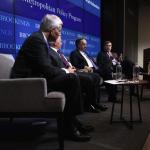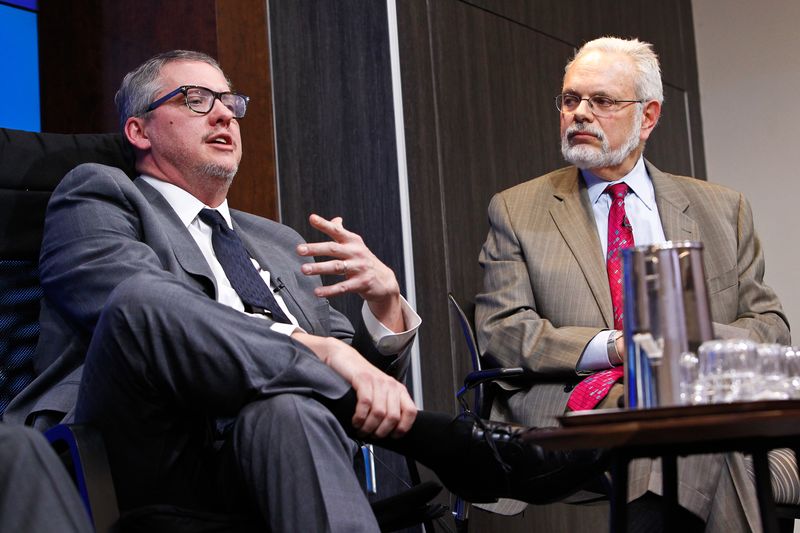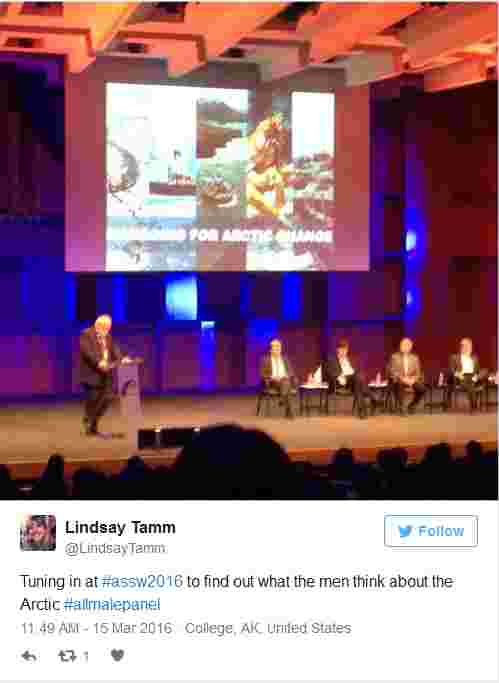The #ManPanel Problem: Why Are Female Experts Still So Widely Ignored?

Recently, a group of female scholars analyzed the New York Times’s coverage of the presidential primary, looking at every article from March 2015 through January 2016. They found something striking: 80 percent of the political scientists quoted in those articles were men.
And it's not just the Times: Male experts dominate media coverage. On primetime cable and Sunday news shows, for another example, 75 percent of national security and foreign affairs commentators have been men, according to a New America study.
These sorts of things look bad, but they also are bad: Prioritizing male experts devalues women's work, depriving them of the recognition and public acclaim they might get if they were male. It also reinforces a general impression that men are the experts worth listening to, and women's roles, if anything, are just to assist men in their important work.
When people try to solve the gender imbalance in media coverage, they'll often help or pressure outlets or journalists to feature more women. For instance, a group of female academics recently launched a site called Women Also Know Stuff to help journalists identify female experts. A widely shared Tumblr called Congrats, you have an all-male panel! shames conference organizers. And a number of high-profile experts have pledged to refuse to participate in panels that do not prominently feature women.
But this approach, while laudable and worthwhile, has always struck me as confusing the symptom for the disease.
The core problem isn't journalists forgetting to quote more women, even though that does happen and should be corrected. Rather, like so many issues of inequality, the underrepresentation of women in media is the result of vast cultural and institutional biases that hold women back every step of the way.
After all, it's not as if women in academia and other "expert" institutions existed in a state of pure gender equality that was undisturbed until panel organizers or journalists declined to call them. No, as these women will often tell you, they face countless forms of gender bias long before they reach the point in their professional development where they become quotable, panel-ready experts.
The sad fact is that women's underrepresentation in the media often mirrors their underrepresentation among university faculty, think tank scholars, and business leaders. That's not to say that journalists are blameless — we're not. But women's underrepresentation in media is just the expression of a much deeper problem. Pressuring journalists to quote more women is great, but it's never going to fix that deeper problem — and, if anything, risks obscuring it.
Whose burden?

This is what an "expert" looks like, according to our stock photo service. Shutterstock.com
In 2013, a journalist named Adrienne LaFrance did something that more journalists, as they hear from projects like Women Also Know Stuff, are now doing: She decided to take stock of how often she quotes female experts and gauge whether she has an unintentional tendency to rely on male sources.
But in the spirit of using her platform to both draw attention to the problem and perhaps contribute to a solution, LaFrance went further than most. She conducted a statistical analysis of every article she'd written that year, and then wrote up the results.
She discovered, as I suspect many journalists would, a heavy bias toward quoting and discussing men: Only about 25 percent of the people she mentioned in her articles were women.
Since then, LaFrance has focused on improving parity between men and women in her stories. But when she repeated the experiment earlier this year, analyzing everything she'd written in 2015 (she is now a staff writer for the Atlantic), she found that the ratio of male to female sources had actually gotten worse — now only 23 percent of the people she wrote about were women.
LaFrance’s analysis hits uncomfortably close to home for me. I haven’t conducted such a rigorous review of my own work, but I suspect the results wouldn't be much better. For instance, last spring I spent weeks reporting a feature story on Russian politics, but all of the Russian politicians, activists, and dissidents I quoted were men. In fact, the piece mentioned only one woman — BuzzFeed foreign editor Miriam Elder.
It's not for lack of caring. Many of my friends are political scientists or otherwise the sorts of professionals who might be quoted as experts, and I've watched, even before becoming a full-time writer myself, as the women among them struggle to get the same level of recognition as the men. I am keenly aware that I am part of the problem — but despite my best efforts to interview and quote more women, I'm under no illusion that I'm part of any kind of solution.
If journalists like LaFrance and myself are struggling to give women the attention they deserve despite our best efforts and attention to the task, that suggests this is a problem that goes beyond just journalists forgetting to Google some female experts. I’m not letting myself off the hook here — correcting this problem is something that is and should be an ongoing concern for me.
As I've spent more time at this, trying to include more women in my articles, I've discovered myself bumping up against a problem distinct from whatever subconscious biases I might hold. The people who are established experts, prominent voices, or in positions of authority — the sorts of people I need to call upon to do my job — are overwhelmingly likely to be men.
I sincerely wish I had the power to solve this problem, but I don't. I can dig deeper in the think tank staff pages to find the women mostly stuck in junior positions; I can scavenge for interesting research whose female authors are accorded less publicity; I can identify female policymakers ranked below the men who are usually still in charge; but ultimately none of this will be enough, on its own, to overcome the systemic bias against women. My articles are still going to reflect the world of think tanks, academia, and government as it is, not as I would like it to be.
I welcome my share of the burden in correcting female underrepresentation, but this is not a problem that journalists or panel organizers can solve on their own. It has to be shared by the vast institutions that help create this problem in the first place, and are perhaps also better positioned to correct it.
Men get quoted more because more men are in positions of power and authority

Male movie director Adam McKay discusses his film The Big Short with male Brookings senior fellow David Wessel during a January panel. Paul Morigi/Getty Images
To state the obvious, one reason men get quoted more often than women is that men are much, much more likely to be in positions of authority. And people in positions of power and authority are much more likely to be quoted in the media.
That's not just a matter of the media being blinded by success. Journalists looking for experts need to evaluate their sources’ expertise, not just figure out that they exist. Having a senior title within a well-known organization is an easy proxy for that kind of reliability. And, equally importantly, institutions like think tanks encourage their senior staffers to be publicly visible, and they often have PR departments to help make that happen.
And those senior staffers are mostly men, which means those PR efforts end up amplifying more male voices than female ones. It’s common knowledge that women are underrepresented among high-profile positions such as CEOs of Fortune 500 companies (95 percent men), US senators (80 percent men), or US presidents (100 percent men). But men also dominate the senior ranks of policy and research roles in think tanks, universities, and federal agencies.
Micah Zenko of the Council on Foreign Relations analyzed the gender breakdown of 10 of Washington, DC’s most prominent foreign policy think tanks in 2014 and found that women held only 21 percent of policy-related positions. And as of 2006, women made up only 23 percent of political professors, 16 percent of "senior defense officials" in the Pentagon, and 22 percent of senior leaders in the State Department.
Journalists can try to get around this by speaking to women in more junior positions, but that has its own problems, as institutions often want to publicly promote their (mostly male) senior people, often at the deliberate expense of junior staffers.
For example, some think tanks don’t allow junior staffers to be quoted as representing their institutions. In other words, a junior researcher can be quoted as "Jane Doe, who researches newsworthy topic Y," but not "Jane Doe, a junior fellow at the Newsworthy Topic Y project at Important Think Tank." That diminishes the expert’s credibility in the eyes of readers, which can make the quote seem less valuable to the piece.
These are all problems with deep roots not in journalism, but in the institutions that journalists cover and rely on for expertise.
Journalists can't fix problems that begin long before we pick up a phone. We can't take on the burden of correcting for institutions that undervalue women's expertise. Those problems go much deeper than just whom journalists decide to interview — but it's for precisely that reason that they're so much more important to address.
Why think tanks and academic institutions favor men

So why aren't there more women among senior think tank fellows, tenured academic faculty, and senior policy officials in the government?
It's likely that some part of the disparity is due to issues that affect women across all professions, such as the burdens of pregnancy and child rearing that fall disproportionately on mothers rather than fathers.
But there are also more specific biases at play here.
For instance, when UCSD political science professor Barbara Walter and two graduate students reviewed more than two decades of international relations articles published in peer-reviewed journals, they found that articles by women were consistently less likely to be cited than articles by men.
One reason for that, they found, was that men tended to cite articles by other men, while women were more likely to cite articles by other women. But because the vast majority of international relations scholars are men, that citation bias provided a huge boost to male scholars at the expense of their female colleagues.
Citation counts can impact tenure decisions, promotions, and hiring. So when male scholars' citation counts get a boost because of their gender, that helps men succeed — which, in turn, keeps academia male-dominated and perpetuates the men-citing-men dynamic. That same dynamic also likely fuels the gender disparity at think tanks, which are naturally keen to promote scholars whose work is influential within their fields.
And while Walter's work looked only at academic citations, it seems likely that the same pattern could play out in other areas as well. If male scholars are more likely to mentor other men or include them in informal professional networking, for instance, that also could accelerate junior male scholars' careers past their female peers.
The uncomfortable truth: Sometimes it makes sense for women to censor themselves
But seniority isn't the whole story here. There's also the confidence gap, which can play into every stage of a woman's career. But it even exacerbates gender biases between men and women who reach similar professional stature.
Research shows that men tend to be more confident in their opinions and less worried about being publicly wrong. That can make them more willing to make bold predictions and sweeping arguments. That's not necessarily the way to ensure accuracy — it's called "overconfidence bias" for a reason — but it does make for entertaining quotes and lively panels. Women, by contrast, tend to be less overconfident in their expertise and thus less willing to make sharp and sweeping arguments in public.
That's not to say that women are making the wrong choice by being careful about their public statements. It's likely, after all, that women need to work harder and be more careful about errors in order to be taken as seriously as their male peers because of biases like the citation gap described above. Being extra careful makes women less likely to be caught saying something incorrect in public, so it might, on balance, be worth it. But it also means they're less likely to give pithy quotes than men who don't have to be so careful.
That's a dynamic I've encountered in my own reporting again and again: Women I interview are much more cautious about hewing closely to their own research and area of expertise, and much more likely to insist on speaking off the record when making a controversial or critical argument. My male sources, on the other hand, are much more willing to freely hold forth on whatever I ask about, confident that whatever opinions they might have are useful enough to share with my readers.
The result is often that female experts give me little information beyond what I already know from reading their published work — and that the men's quotes are the ones that survive final edits.
Focusing on the obvious problem obscures the deeper one
It isn't surprising that the gender balance of expert quotes and panels is drawing so much attention right now, or that it's often treated as a media problem rather than an institutional one. After all, it's easier to notice the frequency with which popular articles quote women than it is to detect subtle institutional biases. And it's easier to demand parity on expert panels and talk shows than to convince male scholars to give their female colleagues' work its proper due.
It's just simpler, in this case, to demand treatment for the symptoms than a cure for the disease. You can tweet a journalist to pressure them to quote more sources in their next piece and plausibly expect a result, but you can't really send a few tweets to @DeptofDefense and imagine that the Pentagon will suddenly promote hundreds of female officers.
Addressing those deeper problems means taking on the much harder tasks of pressuring those institutions to promote more women, and also of addressing less overt biases, such as the citation gap Walter found. I don't have an easy solution to those, and in the meantime it makes perfect sense to continue guiding journalists to quote more women. But let's not fool ourselves into seeing that as more than the stopgap that it is.
